 |
|||||||||||||||
“Columbia” Prepares for the Future Space Shuttle Orbiter 102 undergoes major modification at Boeing’s Palmdale plant by Michelle Evans
The Space Shuttle fleet is nearly 20 years old and the technology on which the systems were built date back even further. The original intent of the shuttle was to be a cargo truck that carried crew and supplies to and from the Space Station. We are only now closing in on this goal. In the meantime the shuttle has served as satellite and planetary probe launch pad, micro-gravity experiment facility, as well as putting some of the components of the International Space Station into orbit so that the shuttle finally has a place to go to fulfill its original mission.
Current estimates show that the shuttle orbiters will be used for another 20 to 30 years. To achieve this longevity, major modifications have been ordered which will bring the fleet up to more modern standards.
The most notable of these changes includes a new system called MEDS. This is the Multi-function Electronic Display System. It is also known in simpler terms as the “glass cockpit” (see O.C.SPACE, Nov. 98). The MEDS system will replace three original-equipment cathode ray tubes and a good portion of the dials and meters that used to show the crew the status of the shuttle. MEDS instead uses nine flat-screen, full-color liquid-crystal displays to do this job. Not only will this make the orbiter safer to fly, it will make it much faster, cheaper, and easier to maintain.
Accomplishing these changes means that each orbiter will be sent back to the original construction plant at Palmdale, in the California desert, for extended periods of what is known as a “major mod.” Atlantis has already undergone the MEDS upgrade and first flew into orbit in April. Columbia is the second or the four orbiters to return to Palmdale.
Since Columbia was the first shuttle orbiter to enter space (April 12, 1981), it was instrumented heavily for the original flight tests. Now, with 26 spaceflights of this vehicle completed, it is felt that much of the wiring for the instrumentation can be removed and Columbia will become a much closer companion ship to the rest of the fleet. In addition, this wire removal will save 1800 pounds of weight which directly translates into larger payloads carried into space.
The last flight of Columbia (STS–93 in July 1999) also has shown that problems have crept into the orbiters over the years as wiring became damaged inadvertently during maintenance. At launch, Columbia nearly lost engine power because of faulty wiring, which would have been disastrous that close to the ground with no way to abort.
Now that Columbia has returned to Palmdale, extra care is being spent to go through literally every wire and connection to look for any possible damage. When the MEDS modifications, wiring inspections, tile repairs, and all the rest are completed later this year, Columbia will be returned to the Kennedy Space Center in Florida and returned to service.
About six months into the year-long modification process, it is hard to believe that Columbia ever flew in space. Hidden under layers of scaffolding it looks more like a giant jigsaw puzzle with many pieces still in the box. Some of these pieces have been removed completely to support operational orbiters at KSC. One such device is the power drive unit in the tail that controls the shuttle’s rudder and speed brake which was installed on Atlantis due to a lack of spare parts.
Everywhere you look, there are green tags hanging from heat protection tiles, electronic components, and mechanical assemblies. These tags are “Squawk Location Tags,” or places where work has yet to be completed.
Temporary clean rooms are set up at many locations such as the engine compartment at the rear of the orbiter and around the doors on the belly of Columbia where fuel connections are made with the External Tank. These are created by sealing the area with transparent green plastic and duct tape. Anyone that goes inside a clean area must wear a “bunny suit.”
The most notable clean room environment is the flight deck of the orbiter itself. Next month we will take you on the inside of the cockpit of Columbia as we follow the process to upgrade the Space Shuttle.
------------------------------------------------------------------------------------------------------------------
Inside the Space Shuttle Part two of our exclusive look inside "Columbia" as it undergoes modification by Michelle Evans
Welcome back to our exclusive coverage of the ongoing major modifications to Space Shuttle Columbia now in process at the Boeing assembly plant in Palmdale. Last month we covered what was happening to the exterior of the shuttle orbiter. This month we go inside and literally see behind the panels on board Columbia's mid-deck, flight deck, and cargo bay.
To enter the shuttle's interior space requires extra care since contamination must be avoided at all costs. The primary barrier for this is accomplished by setting up a clean room environment that must be passed through to gain access. An outer airlock is first entered where a full body suit must be put on.
The body suit comes in several pieces: the primary suit that covers most of the body, then a cap for your hair, and two boots that slip over our shoes.
Once we are suited up in what workers call "bunny suits," it is time to enter the inner airlock which leads to the crew access hatch on the forward left side of the orbiter. We climb a few steps to a platform and then have to get down on our knees to crawl through a circular tunnel. This metal tunnel slides through the hatch and protects it from damage during maintenance.
Once through the tunnel we can stand up. We are now inside the space shuttle crew cabin. This cabin is made up of two levels: the mid-deck and the flight deck. The hatch leads to the lower level, which is the mid-deck. In this area is where the galley, experiment lockers, sleeping quarters, and waste management system (bathroom) are located. In the case of Columbia, the mid-deck also houses the airlock that leads to the cargo bay. In the other three operational orbiters (Discovery, Atlantis, and Endeavour) this airlock has been moved to the cargo bay itself. This frees up a lot of room in the very crowded mid-deck.
Putting the airlock in the cargo bay is part of the changes done to other orbiters to accommodate their use with the International Space Station (ISS). Columbia is the oldest orbiter and is not scheduled for travel to the ISS, so this modification was deemed unnecessary for now.
Normally, upon entry to the shuttle cabin, you would see walls of the equipment lockers. Everywhere would also be little squares of velcro where astronauts could stick things while on orbit to prevent them from floating through the cabin.
But now Columbia is exposing her inner workings with lockers removed and wire bundles showing everywhere. On the forward wall is an equipment bay. Looking up through the maze of wires we can even see the back side of the flight deck, one floor above.
The most amazing thing is that when seen on orbit, the shuttle looks spacious, with astronauts floating easily from place to place. While in Earth gravity the story is very different. There is nowhere we can stand and place our hands out and not touch something. Very close quarters indeed. It is even more noticeable when we realize that when all the equipment is put back in place, and the clean white walls again go up to cover the wires and lockers, these walls will have moved inward even more.
From the mid-deck we take a ladder up to the flight deck. This is the heart of the shuttle. Directly in front of us when we pop through the hatch are the controls for the Remote Manipulator System (RMS, or robot arm) The RMS is used for moving large payloads such as satellites or science packages out of, and back into, the cargo bay.
Turning around we see the stations for the shuttle Commander and Pilot. The blank framework will soon be filled by the new "glass cockpit" or MEDS (Multi-function Electronic Display System).
MEDS will provide the shuttle flight deck with a whole new look and allow it to function well into the 21st century. Each of the eleven new digital displays are interchangeable. Nine screens will be in the cockpit (five in the center and two each in front of the Commander and Pilot). The other two screens will be used at the aft flight station for cargo bay and RMS control. One fascinating aspect of this major upgrade is that the basic shuttle wiring will stay the same, as will the computers that run the systems.
Above the cockpit displays is where we get to look out into space. Five windows look forward, two aft windows look into the cargo bay, and two more are above you. Being a few inches over six feet tall, when I stand I have to duck my head slightly so as not to touch the upper windows.
Exiting the crew cabin, we then have to crawl through an even smaller hatch to enter the cavrenous cargo bay. To facilitate work here, a two-story catwalk is currently installed. Flooring has been removed, exposing the bare structure of the orbiter itself. When cleaned up and ready for space, this bay can easily hold a full-size school bus with room left over.
What an amazing trip it has been to see the inner workings of such a complex space vehicle. We're looking forward to the rollout of the new and improved Columbia later this year.
OCSS wants to express our thanks to Beth Hill and Alan Buis of Boeing for making this visit possible, and to Al Hoffman for being a great tour guide. XXXX |
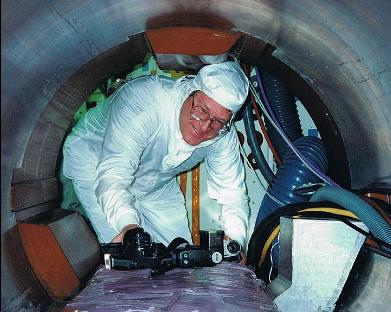 |
|||||
Entering the access tunnel to climb aboard Columbia. |
||||||
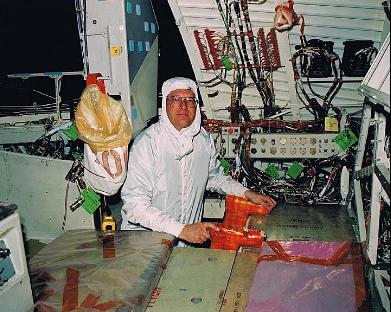 |
||||||
Using the mid-deck access ladder to enter the flight deck. |
||||||
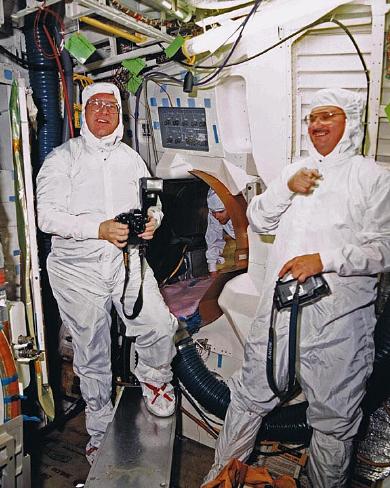 |
||||||
Al Hoffman (R) holds my video camera as I take still photos. |
||||||
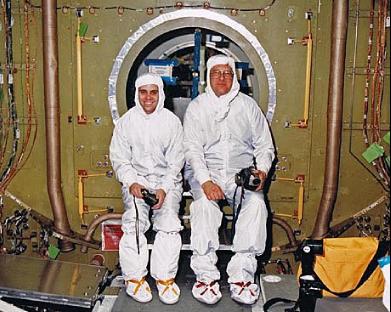 |
||||||
Jeff and I in Columbia's cargo bay hatch. |
||||||
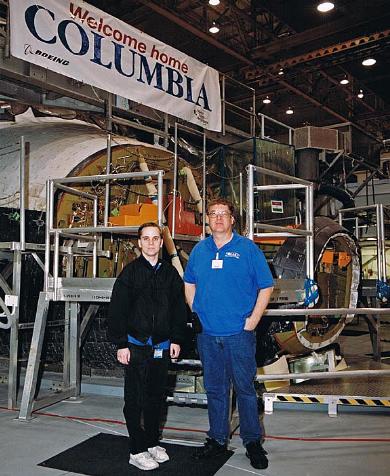 |
||||||
After the interior tour, near the nose of Columbia. |
||